Revised 27 April 2022
Accepted 24 October 2022
Available Online 21 November 2022
- DOI
- https://doi.org/10.55060/s.atssh.221107.022
- Keywords
- Mei Qing
Paintings of Huangshan Mountain
Spectacular landscape
Observing small things from big ones - Abstract
For the paintings of Huangshan Mountain drawn by Mei Qing, “spectacular landscape” seems to be a more appropriate footnote than “real scene landscape”. This article summarizes the creative techniques of Mei Qing's spectacular landscaping: exaggerating the objective scenery, writing more about the sea of clouds, and combining landscapes. Through these means, the scenery of Huangshan Mountain is endowed with vigorous vitality and becomes the spiritual destination of the painter.
- Copyright
- © 2022 The Authors. Published by Athena International Publishing B.V.
- Open Access
- This is an open access article distributed under the CC BY-NC 4.0 license (https://creativecommons.org/licenses/by-nc/4.0/).
1. INTRODUCTION
In the early Qing Dynasty, there existed a group of painters in southern Anhui who liked to take nature as their teacher, and their works were often labeled as “real scene landscape” by scholars today. Among them, Mei Qing (1623-1697), known as one of the “Three Masters of the Huangshan School of Painting”, is a more noteworthy example. It is true that the formation of Mei Qing's artistic style is inseparable from the influence of the landscape of his hometown Xuancheng and the scenery of Huangshan Mountain. However, if the concept of “real scene landscape” is used to measure his creation, it is quite debatable. In ancient Chinese painting theory, “real scene” doesn't refer to the objectively existing natural scene. Da Chongguang, a painter in the early Qing Dynasty, said: “It is difficult to make specific descriptions of void things. But if the real scenery can be clearly depicted, then the void part can also be revealed in the viewer's mind… If the positional relationship between the scenes is not appropriate, then everything depicted will look like a burden. If we can make the void part and the real part cooperate with each other and interact as both cause and effect, then the blank space in the picture will also become a wonderful part” ([1], p.694). In the context of ancient Chinese painting, “real scene” refers to the “painted place” in the picture, which is a concept relative to the blank space in the picture. What people call “real scene” today seems to emphasize the authenticity of the scene painted by the painter and it has a certain value tendency of Western realism. Obviously, this concept is not suitable for the discussion of traditional Chinese landscape painting. As Shi Shouqian said: “Since the tenth century, some specific real scenes can be seen in landscape paintings from time to time, but they are often absorbed by ideal landscape soon after, and gradually lose their original local reference. Sometimes only the superficial husks of titles or schemas remain” ([2], p.246).
From this point of view, the rationality of defining Mei Qing's works with “real scene landscape” has been greatly weakened. So how should his landscape works be defined? By viewing Mei Qing's poems and painting titles, it can be seen that “spectacle” is commonly used by Mei Qing when describing his tours and painting objects. For example, he wrote in “Huangshan Mountain Atlas” (黄山图册) in 1690 (16 pages, collected by the Palace Museum, Beijing) and “Wenshu Monastery” (文殊院) in “Huangshan Mountain Atlas” in 1692 (10 pages, collected by the Palace Museum in Beijing) that: “Wenshu Monastery is located in the center of the Huangshan area, with Tiandu Peak on the left and Lianhua Peak on the right, surrounded by many lower peaks. Sometimes the clouds and mists fill it in an instant to form sea-like scenery, which is very peculiar” ([3], p.11+p.25). When he visited Huangshan Mountain for the first time, he also sighed with emotion that, “Even if one loses his life because of visiting such a peculiar landscape, it is worth it” ([4], p.439). And his interest in “spectacles” should actually be the result of the influence of the growing tourism wave since the late Ming Dynasty and the social and cultural atmosphere of the publication of various “travel books” (such as “Newly Engraved Wonders Within the Four Seas” (新镌海内奇观), “Gu's Painting Collection” (顾氏画谱)”, etc.) that guide people to “search for spectacles”. From this point of view, “spectacular landscape” seems to be a more appropriate footnote to Mei Qing's works, especially works with the theme of Huangshan Mountain. So, how do Mei Qing's paintings of Huangshan Mountain show the spectacle? Generally speaking, the so-called “spectacle” means that the image of Huangshan Mountain in his pen presents an effect that transcends ordinary visual experience. Through the investigation of related works, this paper analyzes the methods and aesthetic implications of Mei Qing's spectacle creation, in order to form a more in-depth understanding of the creation of his paintings of Huangshan Mountain.
2. EXAGGERATING THE LANDSCAPE FEATURES OF HUANGSHAN MOUNTAIN
The scenery of Huangshan Mountain plays a pivotal role in Mei Qing's artistic career, so that some scholars believe that “Only after they climbed Huangshan Mountain and took it as their teacher, the identity of Mei and Shi (Mei Qing and Shi Tao) as painters was finally established” ([5], p.33). This view may not be accurate. But it is undeniable that his artistic achievements are largely inspired by the scenery of Huangshan Mountain. Specifically, the peculiar landscape of Huangshan Mountain has greatly expanded Mei Qing's visual experience and creative concept. One of the manifestations is that the painter achieves the transcendence of the real landscape of Huangshan Mountain by exaggerating or abstracting characteristics of the objective scenery in his creation.
Viewing related works, it is not difficult to find that Mei Qing prefers to exaggerate some peaks of Huangshan Mountain into slender and curved postures. For example, in the “Lotus Peak” (莲花峰) scroll (Fig. 1) now in the Palace Museum and the “Lotus Peak” in “Huangshan Mountain Atlas” in 1690 (8 kai, collected by the Palace Museum in Beijing), Mei Qing shows the audience an amazing and peculiar landscape: the Lotus Peak is transformed into a blooming lotus posture. Similar processing can also be found in works of the “Tiandu Peak” (天都峰) scroll (Fig. 2) now in the Liaoning Museum, the “Tiandu Peak” scroll now in the Palace Museum, and “Xihai Gate” (西海门) (Fig. 3) in the “Nineteen Scenes of Huangshan Mountain” (黄山十九景册) in 1693. The mountain peaks in the picture are either thin and steep, twisting upwards, or slender and curving, upwards like a vine. Judging from general visual experience, many of the actual mountain peaks in Huangshan Mountain are not common. However, compared with the related scenic spots drawn by Mei Qing, the degree of “spectacle” is really “inferior”. That is to say, for Mei Qing, the Huangshan Mountain landscape is admittedly the source of material for his creation, but it is also the object he intends to surpass. One of the means to achieve this goal is to present mountain peaks in the form of growing plants, just as Mei Qing said in the poem in the “Lotus Peak” scroll (collected by the Palace Museum): “Who plants the seed of spirituality? Such a splendid lotus flower blooms on the earth. It is bathed in the sweet dew and holds up rosy clouds. ...When will it bear the lotus seeds? Then I will definitely be rowing a raft to pick it up”. Combining the poem and the content of the picture, it is also easier to understand the painter's attempt to express the inner life of objective nature, in order to realize the connection between the individual and the nature. Through this processing, the mountain peak's posture is quite dynamic, which seems to contain vigorous vitality. People can't help but think of what Gu Kaizhi said in “On Painting Yuntai Mountain” (画云台山记): “... Draw five or six purple rocks like thick clouds, with the hills in between extending upwards, making the mountain situation looks like a winding and swimming dragon. Draw some more hillsides below to make them look condensed and have upward momentum...” ([6], p.141). Although Mei Qing doesn't draw the Huangshan Mountain based on Gu's argument, it is clear that their emphasis on “momentum” in landscape arrangement is highly consistent. Only when the painted objects are dynamic can the viewer “feel the condensed and upward momentum of the rocks”, so that the landscape in the painting can obtain eternal life posture.
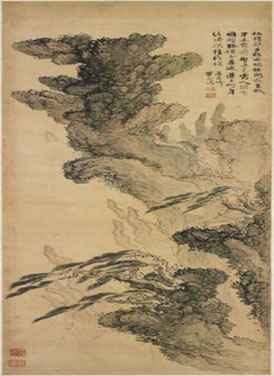
Mei Qing's “Lotus Peak” scroll, colored fabric painting, 186.8 x 57cm.
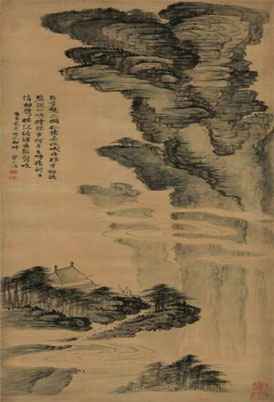
Mei Qing's “Tiandu Peak” scroll, Chinese ink paper painting, 184.2 x 48.8cm.
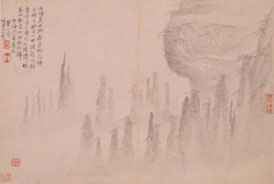
Mei Qing’s “Xihai Gate” (1693) in “Nineteen Scenes of Huangshan Mountain”, colored paper painting, 33.9 x 21.9cm. Collection: Shanghai Museum.
It should be pointed out that the visual experience and creative concept obtained from Huangshan Mountain actually also influence some of Mei Qing's non-Huangshan Mountain-themed creations. Although these works don't have the name of Huangshan Mountain, they remain the temperament of Huangshan Mountain. For example, in the “Jingting Jise Tu” (敬亭霁色图) (collected by the Shanghai Museum) drawn in 1683, the monumental Jingtingshan Mountain is thin and steep, which is very different from the objective scenery. The painter obviously greatly exaggerates the mountain situation and integrates the strange and dangerous features from Huangshan Mountain into the painting, giving the viewer a very strong visual impact. In addition, the “void” of the clouds and mists at the foot of the mountain echoes the “reality” of the pine trees and the flowing spring, which also increases the sense of life of the picture. The “Fang Huangheshan Qiao Biyi” (仿黄鹤山樵笔意) (collected by Shanghai Museum, Fig. 4), drawn in 1690, is also an example. Judging from the content of the picture, this painting is a re-creation of the “Bojian Flying Bridge” in Xuancheng's wonderful scenery. In the picture, the columnar mountain peaks stretch from the foreground to the background in an S-shaped trend. The grass and trees in the mountains are in leafy profusion, the white waterfall hangs down, and the clouds and mists are lingering, presenting a scene full of vitality. Obviously, the intention of the painter is not to passively accept the natural scenery, but to entrust the soul to it and to recreate an organic landscape world by communicating with it. This move seems to be connected to Guo Xi's discussion on the life of mountains and rivers: “Mountains use rivers as their blood, grass and trees as their hair, and mists and clouds as their spirit. Therefore, mountains are alive with rivers, luxuriant with grass and trees, and elegant and graceful with mists and clouds” ([7], p.499). Under the observation of this kind of consciousness, the complementary rocks, forest springs and clouds and mists in the picture are endowed with inner life force, and also become the spiritual sustenance of the painter.

Mei Qing’s “Fang Huangheshan Qiao Biyi” (1690), colored paper painting, 345 x 127.3cm. Collection: Shanghai Museum.
3. WRITING MORE ABOUT THE SEA OF CLOUDS
In the inscription of the picture “Jiulong Waterfall in Huangshan Mountain” (黄山九龙瀑) wrote in 1935, Zhang Daqian made this appreciation of the paintings of Huangshan Mountain of “Three Masters of the Huangshan School of Painting”: “Most of the mountain peaks in Huangshan Mountain are steep and thin and there are many pine trees up and down the mountain... Jian Jiang can often show the skeleton of Huangshan Mountain, Shi Tao can often show the spirit of Huangshan Mountain, and Mei Qing can often show the change of Huangshan Mountain” ([8], p.99–101). Among them, it is quite proper to talk about Mei Qing's ability to express the “change” of Huangshan Mountain. “Change” refers to the unpredictable changes of Huangshan Mountain, which is largely due to the endless spectacle of the sea of clouds in Huangshan Mountain (therefore Huangshan Mountain is also named “Yellow Sea”1) ([4], p.268; [9], p.656). And this kind of spectacle is also one of the objects that Mei Qing is particularly fascinated by. For example, in “Huangshan Mountain Atlas” (16 pages, collected by the Palace Museum, Beijing) in 1690 and “Huangshan Mountain Atlas” (collected by the Palace Museum) in 1692, almost every page has the expression of the sea of clouds.
Judging from the content of the picture, Mei Qing's purpose of doing this is to express the spectacle of “immortal mountains on the sea”. For example, in his “Huangshan Mountain Atlas” in 1690 (16 kai, collected by the Palace Museum), on the page of “Fuqiu Peak” (浮丘峰) (Fig. 5), he makes up three peaks floating on the sea of clouds shown by the blank, which seems to coincide with the meaning of the three immortal mountains on the sea of Fanghu, Penglai and Yingzhou in myths and legends. The inscription in the painting also verifies this meaning: “The Fuqiu Peak is like the three immortal mountains on the sea, which can be seen but can't be touched. I painted this scene with an ethereal feeling in a casual manner. However, it doesn't necessarily look like this in reality”. A similar processing can also be found on the page of “Painting of the Unfolded Sea” (铺海图) in the “Nineteen Scenes of Huangshan Mountain” (Fig. 6): the painter places the three peaks of Lotus Peak, Manjusri Terrace and Tiandu Peak side by side in the clouds and mists, creating an ethereal atmosphere that fascinates him. These pictures often give the viewer a feeling of being likely real or likely illusory, which is beyond reach. This sense of inaccessibility can also be experienced by the painter in the arrangement of composition. Among the above-mentioned works of two pages and many other works such as “Shixin Peak and Raolong Pine” (始信峰与绕龙松) (Fig. 7) and “West Sea Gate” (西海门) in “Huangshan Mountain Atlas” in 1692 (collected by the Palace Museum), such processing can be seen: the mountain peaks are not protruding from the bottom of the picture (the foot of the mountain is not visible in the mountain body), and there is a certain blank (clouds and mists) between the two. The result of this is that when viewing the painting, the viewer has a “feeling of alienation” from the picture both visually and psychologically, thus strengthening the immortal mountain characteristics of the object and creating a feeling of “separation between immortals and mortals”. And those buildings and figures in the painting are like fairy palaces and immortals that are generally out of reach.
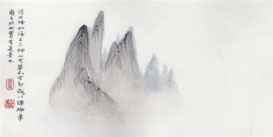
Mei Qing’s “Fuqiu Peak” (1690) in the 16-kai version of “Huangshan Mountain Atlas”, colored paper painting, 22.5 x 38.2cm. Collection: Palace Museum.

Mei Qing’s “Painting of the Unfolded Sea” (1693) in “Nineteen Scenes of Huangshan Mountain”, colored paper painting, 33.9 x 21.9cm. Collection: Shanghai Museum.
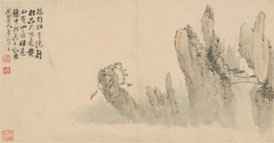
Mei Qing’s “Shixin Peak and Raolong Pine” (1692) in the 10-kai version of “Huangshan Mountain Atlas”, colored paper painting, 20 x 38.1cm. Collection: Palace Museum.
In addition to expressing the immortal mountains, the ever-changing clouds and mists also help to strengthen the conveyance of the picture's sense of life. They and strange peaks are not only the two most important elements in the image of immortal mountains, but also a concrete representation of the concepts of “void” and “reality” in traditional Chinese painting discourse. In the ancients' discourse, clouds and mists are related to the “qi” that can be transformed into all things, difficult to touch and in a constant state of change, and therefore extremely vital ([10], p.137–138). In Mei's works, the “real” strange peaks and the “void” floating clouds are intertwined, forming a mysterious and dynamic atmosphere. As Zong Baihua said: “The myriad phenomena represented in Chinese paintings are of unity and coherence in traveling in the universe by themselves. The artist's rhythm composed of yin and yang as well as void and reality is immersed in the ethereal spirit, but reciprocating, lingering and circling, caressing all things, and excavating the source of beauty in the soul to examine the beauty of all things” ([11], p.197). Obviously, this is an idealized landscape, which not only carries the life of nature, but also symbolizes the spiritual destination of the painter. This is also clearly reflected in Mei Qing's poems on paintings. As he wrote in “Painting of the Unfolded Sea”: “The temple overlooks the blurry world like a fairy palace. ...When can I be like an immortal and entrust my trace in this wonderland-like space?” In the last sentence of the poem, the painter expresses the vision of being able to enter and exit the fairy palace in the cloud like an “immortal”. In the work “Lotus Peak” scroll, Mei Qing also expresses a similar emotion. The projection of this vision into reality can be understood as the painter's diligent pursuit of the ultimate ideal of “enlightenment”. The so-called “Tao” is contained in the “blur” or “heaven and sea” that can be seemingly false and real at the same time in the painting. When the painter is “troubled by sickness and old age” and is unable to visit the spectacles in person, he can still “appreciate landscape paintings instead of strolling about”, in order to carry out the pursuit of “excavating the source of beauty in the soul to examine the beauty of all things” to the end. Perhaps this is the real purpose of Mei Qing's spectacle creation.
4. COMBINING LANDSCAPES
In addition to the above two aspects, combining landscapes is also an important means for Mei Qing to create a spectacle. Specifically, combining landscapes includes two ways. One is the reductive combination of the actual geographic location relationship of the scenery. The other is the mixed arrangement of landscapes, which means that the painter breaks the restrictions of the actual geographical location in a single picture and composes two or more scenic spots2 ([10], p.150–151; [12], p.156–161). The juxtaposition of Lotus Peak, Manjusri Terrace and Tiandu Peak in the aforementioned “Painting of the Unfolded Sea” can be regarded as the former (Fig. 6). The combination of the two scenes of the Alchemy Table and the futon pine in “Alchemy Table and Futon Pine” (炼丹台与蒲团松) in the “Huangshan Mountain Atlas” (collected by the Palace Museum), written in 1692, belongs to the latter (Fig. 8). As a result of combining landscapes, some works inevitably take on the nature of describing the tourism situation or the famous scenic spots, which are often like “tourist handbooks” prepared for the viewers. But even so, Mei Qing doesn't give up his description of the spectacle characteristics in these works.
In the pages of “Pine Valley” (松谷), “Hot Water Bathing Pool” (汤池), “Wenshu Monastery” and “Lotus Peak” in the “Huangshan Mountain Atlas” (collected by the Palace Museum) written in 1692, according to the real geographical relationship, Mei Qing combines the Pine Valley and Cloud Gate Peak, Hot Water Bathing Pool and Xiangfu Temple, Lotus Peak and Tiandu Peak and Manjusri Terrace, as well as Lotus Peak and Lianrui Peak. In addition, the painter also introduces his own travel experience in these works for the reference of the viewers when they tour scenic spots. For example, in the page of “Pine Valley”, Mei Qing provides more specific tour routes, accommodation and other information for viewers: “If you visit Huangshan Mountain from the place where the immortals live, you must stay in the Pine Valley on the first night. On the way from the Pine Valley to Cloud Gate, you can see many bamboo-like peaks. The deeper you go, the more peculiar landscape you can see.” Similar tour information can also found in the “Hot Water Bathing Pool” and other pages, which won't be repeated here. But obviously, only the text description can't very effectively arouse the viewer's interest in the tour. In this regard, Mei Qing's solution is to create a spectacle, so that the audience can have a very deep initial impression of Huangshan Mountain. Therefore, one can see the Lotus Peak that blooms like a lotus flower in “Lotus Peak” and the Lianrui Peak that looks like a lotus bud (Fig. 9), the Cloud Gate Peak that looks like the Heaven Gate in “Pine Valley”, and the Tiandu Peak, Lotus Peak and Manjusri Terrace that look like fairy mountains on the sea in “Manjusri Terrace”... The situation is similar for some works created by the mixed arrangement of landscapes. For example, on the page of the book “Alchemy Table and Futon Pine”, Mei Qing juxtaposes the alchemy table and the Futon pines, which are not too close in reality, in a diagonally opposite posture in the picture. Although this move has the intention of reminding viewers to pay attention to other surrounding scenic spots when they are in one of the scenes, but from the name of the two scenes and the content of the picture, the painter's arrangement should contain other intentions. In the “Huangshan Mountain Atlas” in 1690 (16 kai, collected by the Palace Museum), there is also a page “Alchemy Table and Futon Pine”, and the composition is highly consistent with the former. But there is a poem written by a painter on it: “The place where the Yellow Emperor made elixirs has been desolated. Although the alchemy furnace has cooled down, the scent of Ganoderma lucidum is still permeating... I wonder who can pick up the elixir and rekindle the alchemy furnace?” It can be seen that the painter hopes that the juxtaposition of the Alchemy Table and the Futon pine can remind the viewer of the legend that the Yellow Emperor used to make elixirs here. And the futon pines in the two pages of the work are painted with a meditating Taoist (perhaps the Yellow Emperor), also embodying the painter's such intention. This processing not only brings a visual experience of spectacle to the viewers, but also enhances the cultural thickness of the work.
So, apart from the purpose of creating a spectacle, are there other reasons behind painting in the way of combining landscapes? Viewing Mei Qing's many works, it is not difficult to find that regardless of whether the scenery he composes conforms to the actual geographical relationship, there is no viewing angle in the objective nature that conforms to the viewing angle presented in his works. For example, in his “Huangshan Mountain Atlas” in 1692 (collected by the Palace Museum), on the page of “Shixin Peak and Raolong Pine” (Fig. 7), the adjoining positional relationship between the two scenes is indeed consistent with the description in the picture. But in the actual mountain tour process, it is basically impossible to see the scene as shown in the picture. In other words, the picture presented in the work is not the result of the painter's “in-position viewing”, but a synthesis of the visual experience obtained through the diachronic “tour viewing” method. When the “in-position viewing” can't restore the painter's aesthetic feeling well, the dynamic perspective can make up for this deficiency. The concept of dynamic perspective can be seen as early as in the painting theories of the Northern Song Dynasty. It is said in “The Elegance of the Bamboo and Spring” (林泉高致): “A mountain looks like this when you take a close look at it, and it looks different a few miles away and tens of miles away. Every part of the mountain will have a different look. A mountain looks like this from the front, and it looks different from the side and from the back. It is different when you look at the mountain from every side. In this way, a mountain has the shape of dozens or hundreds of mountains, how can we not understand it carefully?” ([7], p.498). The thinker believes that when creating landscape paintings, painters should observe objects from different distances and angles, and then integrate these feelings and experiences into a harmonious and orderly whole. Mei Qing's related works embody a similar creative concept. In addition to the “Alchemy Table and Futon Pine” mentioned above, on the page of “Tiandu Peak” (Fig. 10) in the “Huangshan Mountain Atlas” (collected by the Palace Museum) in 1692, he also adopts a relatively macro perspective, organically combining Tiandu Peak and Zhusha Nunnery in a sea of clouds and showing the effect of his ideal “Buddhist Temple of Paradise”. In fact, this is also similar to the method of “observing small things from big ones” mentioned by Shen Kuo: “When Li Cheng painted pavilions, terraces and open halls on the mountain, he often painted the eaves from an upward angle. He believed that looking from the bottom up is like a person standing on a flat ground looking up at the eaves of a tower, only to see the rafters. This view is wrong. The general method of painting landscapes is to look at large scenes as small ones, just like people look at rockeries. If a painter draws a mountain as he sees it, he will see only one layer of the mountain from below. How can he see all layers of the mountain? It is even more impossible for him to see the scene in the valley” [13]. Shen Kuo also emphasized that painting should not be a mechanical record of what is seen from a fixed perspective, but should be grasped from a global perspective. Only by looking at the parts from the whole, can an organic and comprehensive picture effect be obtained. Similarly, for Mei Qing, “uplifting painting and flying eaves” are not his method of creation. His focus is more on the overall atmosphere of Huangshan Mountain than on the specific characteristics of a certain mountain, a certain tree or a certain temple. The so-called overall atmosphere of Huangshan Mountain is reflected in the artistic conception of “immortal mountain” in Mei Qing's works. In such an atmosphere, Lotus Peak, Lianrui Peak, Alchemy Table, Futon Pine, Tiandu Peak, Zhusha Nunnery, etc. seem to have been endowed with “reiki” and become things in the wonderland. And these elements together create a vibrant and dramatic atmosphere, which eventually becomes a spiritual space for the painter to wander.
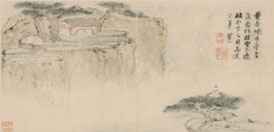
Mei Qing’s “Alchemy Table and Futon Pine” (1692) in the 10-kai version of “Huangshan Mountain Atlas”, colored paper painting, 20 x 38.1cm. Collection: Palace Museum.
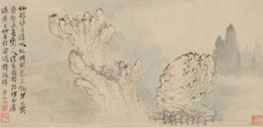
Mei Qing’s “Lotus Peak and Lianrui Peak” (1692) in the 10-kai version of “Huangshan Mountain Atlas”, colored paper painting, 20 x 38.1cm. Collection: Palace Museum.

Mei Qing’s “Tiandu Peak and Zhusha Nunnery” (1692) in the 10-kai version of “Huangshan Mountain Atlas”, colored paper painting, 20 x 38.1cm. Collection: Palace Museum.
5. CONCLUSION
It needs to be clear that the above-mentioned three creative features don't have an obvious division of scope, but are mutually inclusive and mutually dependent. For example, in the works created in the way of combining landscapes, the exaggeration of the characteristics of the scenery and the expression of the sea of clouds can also be seen, and the latter two are to a certain extent the result of the painter's use of a comprehensive perspective to observe nature. These three methods together help Mei Qing to give life to the scenery of Huangshan Mountain and become a habitat for his own soul, and at the same time lead the viewers to travel in the ever-changing imaginary places and appreciate the magic of nature. This kind of spectacle creation is undoubtedly a huge attraction for both the painter himself and the audience. It should also be pointed out that these creative methods and concepts of Mei Qing are also reflected to varying degrees in the creations of other contemporary painters such as Shi Tao, Hong Ren and Dai Benxiao. The common interest in the spectacle creation in the related works of these painters has made them a very special landscape in the painting circle of the early Qing Dynasty.
Footnotes
Mei Qing has repeatedly called Huangshan Mountain the “Yellow Sea”, for instance, he once wrote that “I see the Yellow Sea clearly in my dream and I have been in melancholy for thirty years”, and “I went to the source of the wonderland to embrace the Yellow Sea three times”, etc.
Some scholars also call this technique “Scenery Synthesis”, “Collection”, and so on.
REFERENCES
Cite This Article

TY - CONF AU - Guodong Zhang PY - 2022 DA - 2022/11/21 TI - The Painting Creation of Huangshan Mountain by Mei Qing BT - Proceedings of the 8th International Conference on Arts, Design and Contemporary Education (ICADCE 2022) PB - Athena Publishing SP - 123 EP - 130 SN - 2949-8937 UR - https://doi.org/10.55060/s.atssh.221107.022 DO - https://doi.org/10.55060/s.atssh.221107.022 ID - Zhang2022 ER -









